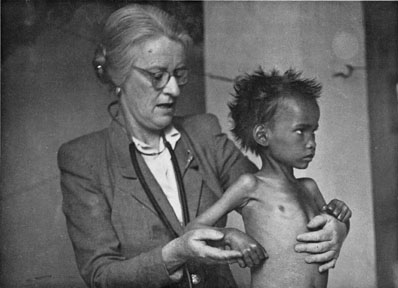Cicely D. Williams
The fact that Cicely D. Williams, our next “most influential doctor of all time”, ended up a female prisoner of war should have been enough to make her renowned; but, …
being the DISCOVERER:
- of the most deadly disease of an era and…
- that it was being treated all wrong, and…
- that the corrupt business practices of the Nestlé Corporation were causing thousands of children’s deaths each year,
cinched the deal for Dr. Cicely D. Williams—a true doctor’s doctor!
Dr. Cicely D. Williams examines a child with Kwashiorkor, the disease she discovered
Cicely D. Williams (1893—1992) – #28
Pioneering Pediatrician, Prisoner of War, Discoverer of Kwashiorkor Malnutrition and Tireless Advocate for Children
Number twenty-eight on the list of all-time influential physicians, Dr. Williams fought not only disease; but also the Axis powers in WW2 – where she became a prisoner of war, and the Nestlé corporation – where she exposed corrupt business practices leading to the death of thousands of children.
Early Life and Education of Cicely D. Williams
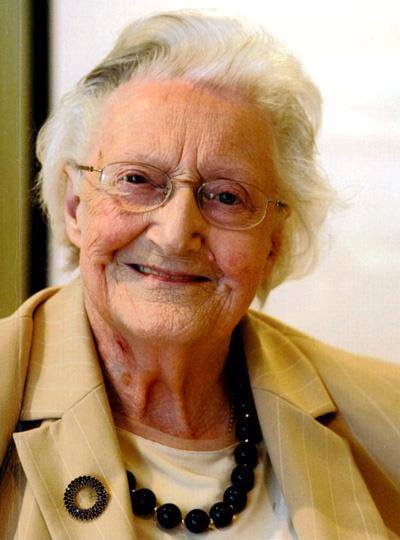
Cicely Delphine Williams was born 2 December 1893 in Kew Park, Darliston, Westmoreland, Jamaica to James Rowland Williams and Margaret Emily Caroline Farewell, long time residents of the country.
When she was nine, her father reportedly told her that she had better become a lady doctor because she was unlikely to find a husband.
She left Jamaica when she was 13 for England where she excelled and was awarded a place at Somerville College, Oxford when she was 19. She had to defer her place at college in order to return and help her parents after a devastating series of earthquakes and hurricanes.
At 23 and the death of her father in 1916, she returned to Oxford and began studying medicine, one of the first females admitted into the course – only because of the lack of male students caused by World War I. Women were otherwise not accepted into the college you see.
Education and Career
At 31, she graduated and qualified from King’s College Hospital in 1923 then worked in Hackney at the Queen Elizabeth Hospital for Children where she decided to further specialize in pediatrics.
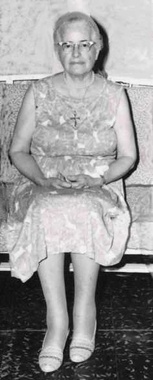
Then came the end of the war and the re-patriation of male physicians making it difficult for her to find a medical position after graduation.
She worked with Turkish refugees in Salonika then went on to complete a course at the London School of Hygiene and Tropical Medicine between 1928 and 29. She applied to the Colonial Medical Service, and in 1929 was posted to the Gold Coast now known as Ghana.
The Colonial Medical Service employed her as a “Woman Medical Officer” which, consistent with the times, meant lower prestige, lower pay, slower advancement and less credibility. Taking over clinic duties she found the illness and death rate of infants and children shocking to her and began training nurses to do out-reach visits.
She started “well-baby” visits and began actually keeping records which required inventing a “card-system” to accomplish it; things we merely take for granted today. Unlike others, she gave credence to traditional medicine and local knowledge. It perplexed her that even though overall child mortality was high, that of toddlers between two and four was even higher!
They also had unusual but similar appearance: swollen bellies, stick-thin limbs, flat-facies, lack of energy and they died even though they were treated for the then-in-vogue diagnosis of pellagra (a vitamin deficiency). The locals called the disease “Kwashiorkor” in their language which Williams translated to “disease of the deposed child.”
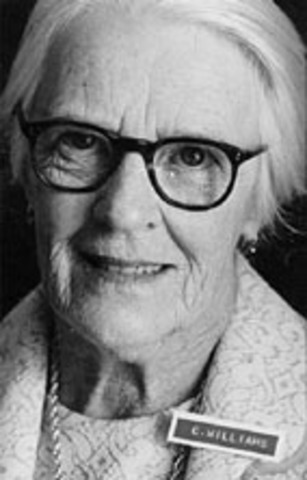
Her autopsy studies and local experience convinced her that it was being mis-diagnosed and improperly treated and that it was in fact due to protein malnourishment. She published her findings in the 1933 Archives of Disease in Childhood.
As we’ve now come to expect, she was attacked by someone who considered himself an expert on African nutritional deficiency and felt threatened, H. S. Stannus, who continued his misguided antagonism into 1935. The fact that the dying babies all had done fine until being weaned for a new baby (i.e. “deposed”) solidified Williams’ opinion; requiring, of course, that she write another follow-up article with examples and facts which contrasted Kwashiorkor and pellagra. It was published by the Lancet in 1935.
Stannus wouldn’t even acknowledge the name “Kwashiorkor” or that the thousands of children, who were still dying in spite of being treated for the Pellagra they were diagnosed with, even had a separate disease.
Incredibly, her continued desire to educate and inform her antagonists clashed with her superiors and got her transferred “in disgrace” to Malaya in 1936 to lecture at the University of Singapore.
Discovered Nestlé Corruption; Japanese Prisoner
As difficult as the conditions were in Ghana, they were even worse in Malaya. There it was the newborn infants who had the extremely high mortality rate! And not only that, but it was being caused by the avarice of a Swiss company.
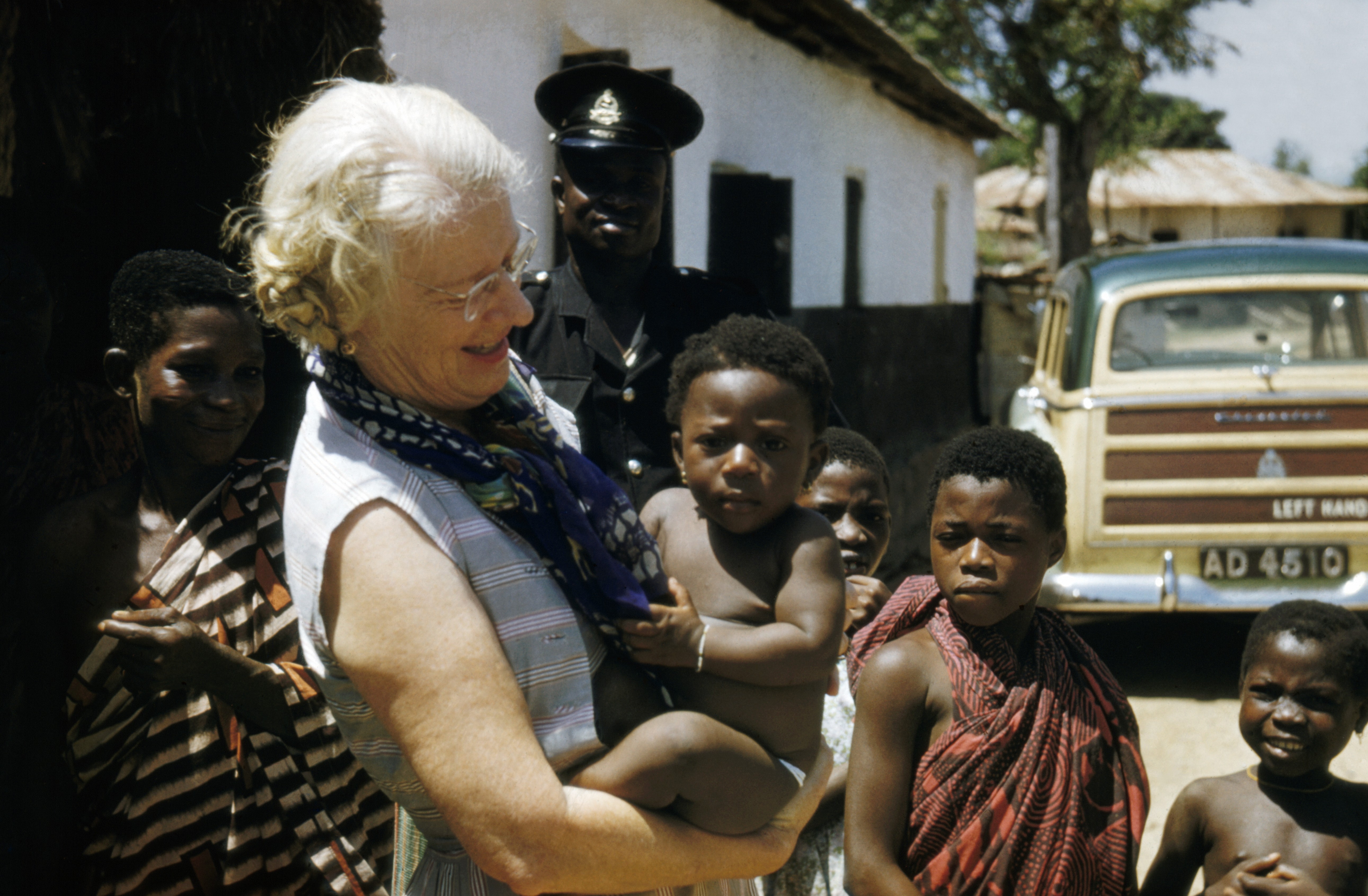
Williams discovered that, even though it was illegal to do so in the US, England and Europe, the Nestlé corporation were hiring women to dress as nurses and go into tenement houses to convince new mothers not to breastfeed and falsely claiming that their imported sweetened condensed milk was better. Nestlé was advertising it as “ideal for delicate infants” and they were dying from diseases brought on by malnutrition.
She oversaw the developed a primary health care center in the province of Trengganu and managed its 23 doctors and some 300,000 patients. As such, she was invited to address the Singapore Rotary Club in 1939 whose chairman just happened to also be the president of Nestlé. [Parenthetical Note: This was the year Hitler invaded Poland at start of WW2]
Unfortunately for him, her speech was entitled “milk and Murder” and she famously said: “Misguided propaganda on infant feeding should be punished as the most miserable form of sedition; these deaths should be regarded as murder.”
Williams and her companions were forced to trek to Singapore for safety in 1941 when the Japanese invaded; but, shortly after her arrival there, Singapore fell too. She became a prisoner of war; first, at the Sime Road Camp and later at Changi Jail with 6000 other prisoners.
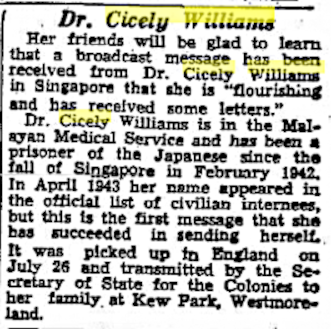
Over three years at Changi she became one of the camp leaders which got her removed by her captors to Kempe Tai Headquarters where she was tortured, starved and kept in cages with dying men. She suffered dysentery and beriberi which left her feet numb for the rest of her life.
When the war ended in 1945 she was in hospital near death!
Later life:
On April 7th, 1948 when the World Health Organization (WHO) was created in Geneva Switzerland who would be better to head the new Maternal and Child Health (MCH) division than a “Woman Medical Officer” who had dedicated her whole life to the care and advocacy of “third world” children around the globe. An endeavor which had quite literally put her life and limb in danger many times.
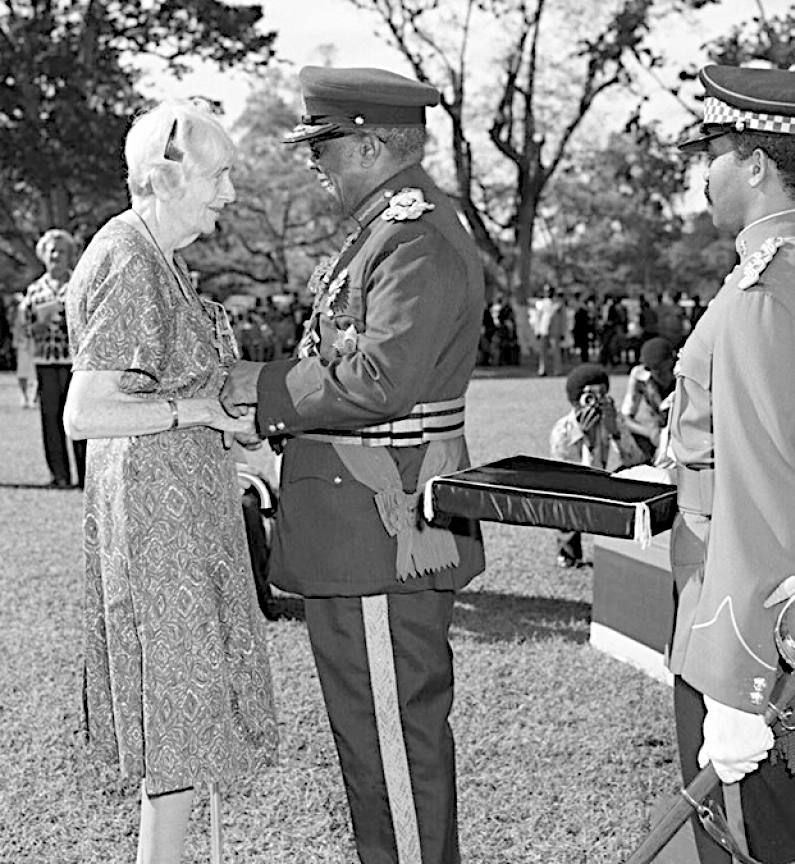
Later transferred back to Malaya to head all maternal and child welfare services in South-East Asia. In 1950 she oversaw an international effort across 10 nations in sub-Saharan Africa with documented that Kwashiorkor represented “the most serious and widespread nutritional disorder known to medical or nutritional science.”
She lectured in over 70 countries and changed organizational attitudes toward accepting local knowledge and resources as key in achieving local health and wellness. She studied “vomiting sickness” in Jamaica in 1951 investigating the causes of food poisoning and identified hypoglycemia from unripe ackee fruit.
She was a senior lecturer in London (’53-’55), a Professor at the American University of Beirut (’60), worked with UN relief agency for Palestinian refugees in the Gaza Strip in addition to Yugoslavia, Tanzania, Cyprus, Ethiopia and Uganda.
She received an honorary Doctorate of Science from the University of Ghana, the Jamaican Legion of Merit Medal, a gold medal from the Royal College of Paediatrics and a silver medal from the UN Food and Agriculture Organization (FAO Ceres Medal).
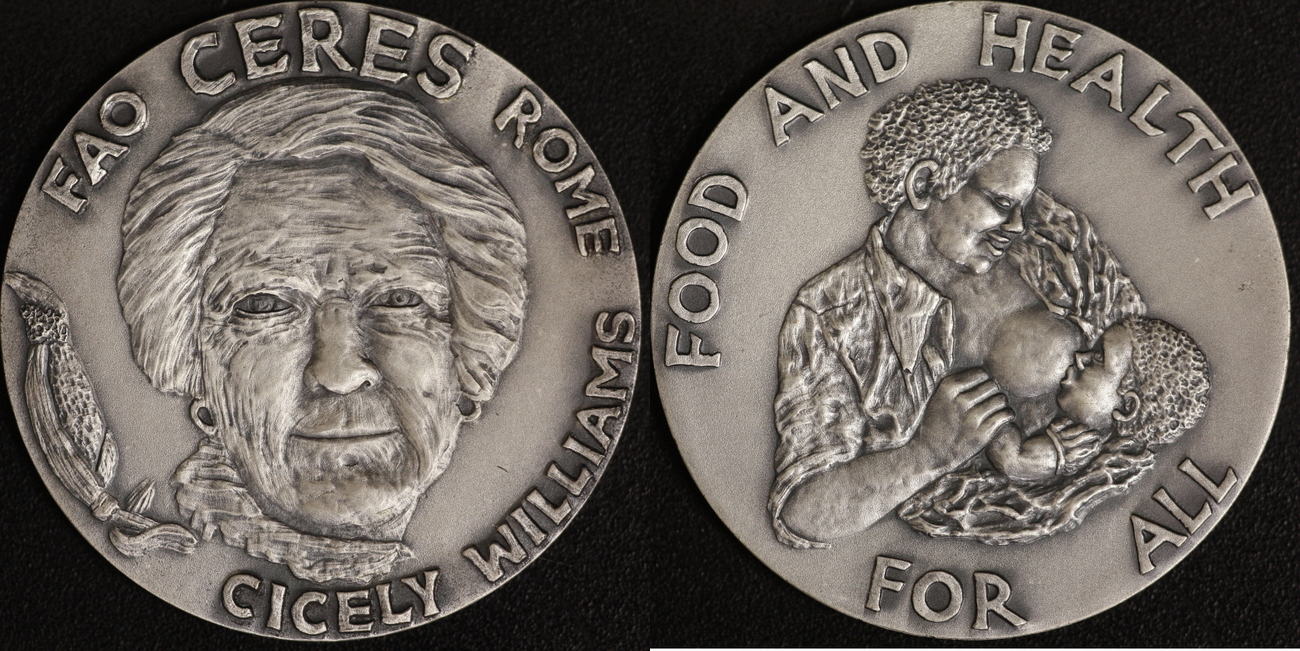
ALL of this after nearly dying under the hands of the Japanese as a POW!
She ‘officially retired’ at the age of 71; but continued actively traveling and speaking into her early 90’s.
Doctor Williams died 13 July 1992 in Oxford, England at the age of 98.
Biographic Summary
Cicely Delphine Williams was a pioneering woman physician/pediatrician who spent her career fighting malnutrition and anyone or thing which was causing it. She discovered Kwashiorkor, was a prisoner of war and became a national leader in children’s welfare.
Born: 2 December 1893, Kew Park, Darliston, Westmoreland, Jamaica
Died: 13 July 1992, Oxford, England (98)
Education: King’s College Hospital, 1923; Queen Elizabeth Hospital for Children, specialty in Pediatrics
Known for: Discovering the severe protein malnutrition known as Kwashiorkor; exposing Nestlé’s corrupt practices which were killing babies; surviving Japanese torture as prisoner of war; strong proponent of breastfeeding; world leader in child care.
Books: “Primary Health Care Pioneer: The Selected Works of Dr. Cicely D. Williams”; “Retired, Except on Demand”.
Parents: James Rowland Williams (1860-1916), and Margaret Emily Caroline Farewell (1862-1953)
26 Posts in Top 50 Doctors (top50) Series
- 26 - Carlos Chagas, Chaga's Disease & pneumocystis pneumonia. – 10 Apr 2025
- 27 - Charles D. Kelman - Cataracts – 9 Mar 2023
- 28 - Cicely D. Williams, Kwashiorkor, Breastfeeding, Whistleblower – 21 Jun 2022
- 29 - Dame Cicely Saunders, Hospice – 23 Apr 2018
- 30 - David L. Sackett, Evidence-based Medicine – 2 Apr 2018
- 31 - E. Donnall Thomas & Joseph Murray, Bone Marrow Transplants – 23 Feb 2018
- 32 - Elizabeth Blackwell, women in medicine – 29 Jan 2018
- 33 - Elisabeth Kübler-Ross, stages of grief – 5 Jan 2018
- 34 - Watson & Crick, DNA – 2 Dec 2017
- 35 - Mahmut Gazi Yaşargil, Micro-Surgery – 24 Oct 2017
- 36 - George Papanicolaou, Cytopathology, Cancer – 29 Sep 2017
- 37 - Dr. James Parkinson, Parkinson's Disease – 1 Sep 2017
- 38 - Dr. John Snow, cholera – 20 Aug 2017
- 39 - Dr. Joseph Kirsner, GI Joe – 27 Jul 2017
- 40 - Lawrence (Larry) Einhorn, chemotherapy – 16 Jun 2017
- 41 - Robert Koch, modern bacteriology – 21 Mar 2017
- 42 - Stanley Dudrick, TPN – 28 Feb 2017
- 43 - Stanley Prusiner, neurodegenerative diseases – 25 Jan 2017
- 44 - Victor McKusick, medical genetics – 3 Jan 2017
- 45 - Virginia Apgar, anesthesiology & newborn care – 12 Nov 2016
- 46 - William Harvey, circulation – 12 Oct 2016
- 47 - Zora Janžekovič, burns – 26 Sep 2016
- 48 - Helen Taussig, blue babies – 3 Sep 2016
- 49 - Henry Gray, anatomy – 3 Jul 2016
- 50 - Nikolay Pirogov, field surgery – 11 Jun 2016
- Top 50 Doctors: Intro/Index – 10 Jun 2016
Advertisement by Google
(sorry, only few pages have ads)

